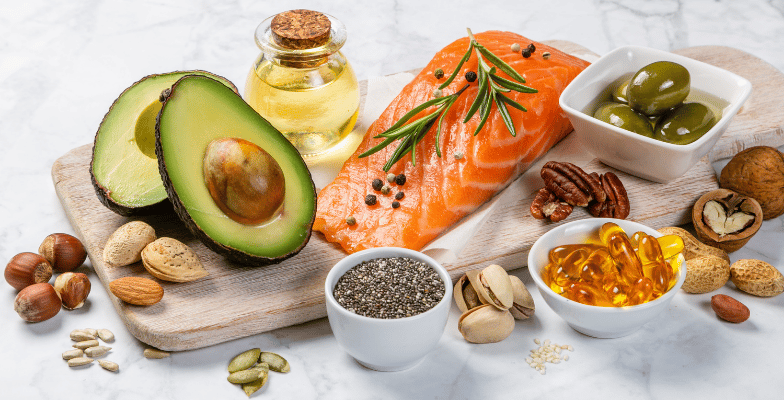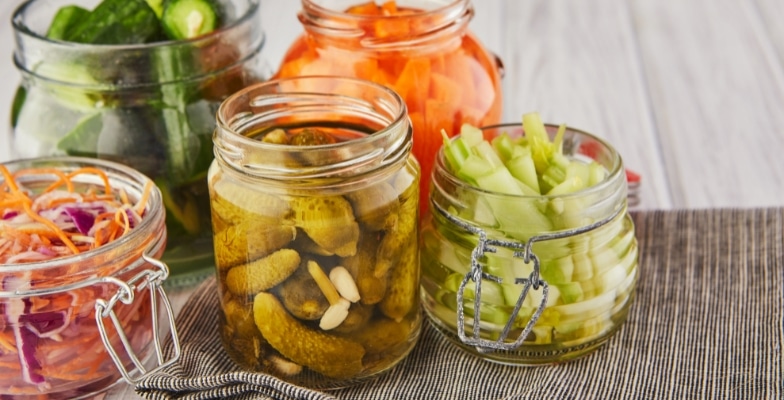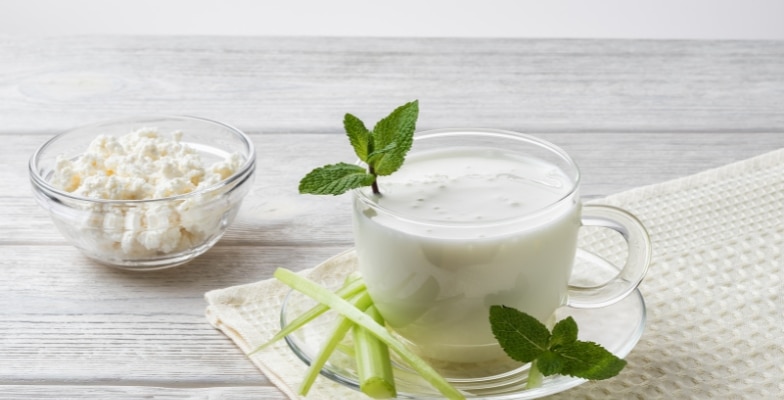Unsaturated Fats | Good Or Bad?
- Saturated Fats
- Unsaturated Fats
- Omega-3 And Omega-6 Fatty Acids: What’s The Optimal Ratio?
- Health Risks Associated With Increased Intake Of Omega-6 Fatty Acids.

Fats are one of the three macronutrients, along with proteins and carbohydrates.
Fats consist of carbon and hydrogen atoms. They are collections of molecules called triglycerides. Triglycerides are formed when three fatty acids attach to a glycerol molecule. If this collection is liquid at room temperature, it can be called oil. If it’s solid, it is referred to as fat.
Lipid is a broad term that includes fats as well as hormones, cholesterol, phospholipids, sphingolipids, sterols, etc.
Fats are mainly categorized as saturated fats or unsaturated fats.
Saturated Fats
Saturated fats are fats that contain single covalent bonds between the carbon atoms of fatty acids.
Each carbon atom is bonded with a maximum number of hydrogen atoms in the molecule, hence the term saturated. Saturated fats are named based on the number of carbon chains in the molecule.
The most common types of saturated fatty acids are caproic acid (6 carbon atoms), lauric acid (12 carbon atoms), stearic acid (18 carbon atoms), and a few others.
Each type has a unique characteristic and plays a unique role in the human body.
Related Article: Saturated Fat: Good or Bad?
Animal fats have a higher percentage of saturated fat than fats in plants. These fats have higher melting points, which is why I recommend them as cooking oils. They are solid at room temperature.
Some common examples of saturated fats are butter, ghee, coconut oil, palm kernel oil, and lard. Red meats like beef, pork, lamb, and parts of chicken also have a high percentage of saturated fat.
Unsaturated Fats
Double bonds between the carbon atoms characterize unsaturated fats.
Do note where double bonds are formed, there are fewer hydrogen atoms bonded to the carbon atom, therefore the term unsaturated. Saturated fats have no double bonds, and therefore are saturated with hydrogen atoms that are bonded with the carbon atoms!
There are two main types of unsaturated fats, monounsaturated and polyunsaturated.
Monounsaturated Fats (MUFAs)
Monounsaturated fats (abbreviated MUFAs) contain just one double covalent bond between two fatty acid carbon atoms. Mono means one. They fats are liquid at room temperature. However, refrigeration may turn them semi-solid or even solid.
The most common type of monounsaturated fatty acid is oleic acid. Other types are paullinic acid, vaccenic acid, etc. MUFAs are mainly found in plant foods. The most common sources of MUFAs are olive oil, almonds, cashews, peanuts, and pumpkin seeds.
The benefits of monounsaturated fatty acids are well documented, and unlike saturated fats not controversial.
Almost every expert agrees that adding olive oil (which has the highest content of MUFAs) benefits heart health by increasing HDL, and some studies have linked MUFAs with lowered blood pressure! 1https://www.ncbi.nlm.nih.gov/pubmed/1609766, 2https://www.ncbi.nlm.nih.gov/pubmed/16287956
More studies link MUFAs with decreased inflammation, which reduces the risk of chronic diseases. 3https://www.ncbi.nlm.nih.gov/pubmed/15383514
Polyunsaturated Fats (PUFAs)
Polyunsaturated fats (abbreviated PUFAs) contain two or more double covalent bonds between two fatty acid carbon atoms. Poly means many. They are liquid at room temperature like monounsaturated fats. And as with MUFAs, refrigeration may turn them semi-solid or even solid.
PUFAs are also found in plant foods. The most common sources of PUFAs are walnuts, canola oil, and seeds like sunflower, sesame, and chia. Avocados are also a good source of polyunsaturated fats.
One crucial fact I would like to point out is that all foods rich in fat contain a mix of different fats.
Generally speaking, saturated fats are found in animal-based foods, whereas plant-based foods are sources of unsaturated fats.
Polyunsaturated fats are subdivided into omega-3 and omega-6 fatty acids. Both are essential fatty acids, which means the human body cannot manufacture them, so you must get them from your diet.
Omega-3 Fatty Acids
Omega-3 refers to the family of fatty acids in which the first cis double bond (unsaturation) closest to the methyl end is in the third position.
Three types of omega-3s are alpha-linolenic acid (ALA), eicosapentaenoic acid (EPA), and docosahexaenoic acid (DHA) Animal foods such as fish and pasture-raised eggs are high in omega-3 fatty acids.
Related Article: Omega-3 Fatty Acids Benefits and Daily Requirement
Omega-6 Fatty Acids
Omega-6 fatty acid is a type of polyunsaturated fatty acid with 18 carbon atoms. The most common omega-6 is linoleic acid, an essential amino acid that the body cannot manufacture on its own.
Omega-6 refers to the family of fatty acids in which the cis double bond closest to the methyl end is in the sixth position.
Plant-based oils are highest in omega-6 fatty acids. Some examples are soybean oil, corn oil, sunflower oil, cottonseed oil, and rice bran oil. Even though polyunsaturated fats are essential, when eaten in excess, they may pose health issues.
There are 9 calories in 1g of fat, and excess fat intake may lead to unwanted weight gain. We all know this. But here, I want to specifically focus on a topic that is not talked about much.
I am referring to the omega-3 to omega-6 optimal ratio.
Omega-3 And Omega-6 Fatty Acids: What’s The Optimal Ratio?
Anthropology studies indicate that humans evolved on a diet with an omega-6 to omega-3 essential fatty acid ratio of approximately 1! That means they ate equal amounts of both.
But unfortunately, the western diet’s ratio is highly skewed in favor of omega-6, typically in a ratio of 15-16.7 : 1. Many experts believe this is a severe health problem. 4https://www.ncbi.nlm.nih.gov/pubmed/12442909
According to the study:
A ratio of 4/1 was associated with a 70% decrease in total mortality. The breast cancer risk was reduced with an improved ratio. A ratio of 2 – 3/1 suppressed inflammation in patients with rheumatoid arthritis and a ratio of 4/1 had a beneficial effect on patients with asthma.
A 2016 study indicates this ratio may be even higher, perhaps 20:1 or more! 5https://www.ncbi.nlm.nih.gov/pubmed/26950145
For optimal health, a ratio of omega-6 to omega-3 of 1 – 4:1 should suffice! The ratio in today’s western diet is skewed because of the soaring popularity of vegetable oils.
The chart below shows the consumption of different types of fats in the past hundred years. You can see the meteoric rise in the consumption of vegetable oils (mainly soybean oil) and a downward trend for lard and butter.

Related Article: Is Ghee Good For Health?
Out of all the vegetable oils, soy grabbed the most market share as it’s cheap. This is why you find soybean oil (both liquid and partially hydrogenated) in many processed foods!

Soybean oil has one of the highest percentages of calories from omega-6 fatty acids. Other oils that are very high in omega-6 are:
-Safflower Oil
-Grapeseed Oil
-Corn Oil
-Cottonseed Oil
-Rice Bran Oil
-Sesame Oil
-Sunflower Oil
Health Risks Associated With Increased Intake Of Omega-6 Fatty Acids.
Vegetable oils like soybean, corn, cottonseed, sunflower, rice-bran oils undergo a lot of processing and refinement before humans can consume them. Most commercially available vegetable oils are converted from their respective plant-seeds using chemical solvents to make them edible.
Scores of scientific studies that suggest that omega-6 promotes oxidative stress, causes chronic inflammation and atherosclerosis. 6https://www.ncbi.nlm.nih.gov/pubmed/9488997?dopt=Abstract, 7https://www.ncbi.nlm.nih.gov/pubmed/5445332?dopt=Abstract, 8https://www.jlr.org/content/50/2/204?ijkey=12c01c7e3097d64cd27b815eebd20500c613f2e7&keytype2=tf_ipsecsha, 9https://www.ncbi.nlm.nih.gov/pubmed/17259442?dopt=Abstract, 10https://europepmc.org/article/med/14203263, 11https://www.ncbi.nlm.nih.gov/pubmed/8466938?dopt=Abstract
It is also likely to increase the risk of coronary heart disease. Omega-6 has many carbon double bonds, which makes them highly reactive and sensitive to heat, oxygen, and light. They can get easily oxidized and turn into free radicals.
What Are Free Radicals? | And Why Should You Care?
Free radicals are highly unstable molecules that can play havoc in the human body. They are molecules that contain an unpaired electron in their outer orbit. Let me give you a basic chemistry lesson that will make the topic of free radicals and antioxidants (which I will discuss in a while) clear!
Everything in the universe is composed of atoms. The subatomic particles that make up atoms are electrons, protons, and neutrons. Protons and neutrons make up the nucleus of the atom.

Electrons are found in the shell or orbitals that surround the nucleus. They revolve around the nucleus in a circular orbit, like the planets orbit the sun! Now, each shell of the atom needs to be filled by a set number of electrons. Once the shell is full, electrons start to fill up the next shell.
In the case of free radicals, the outer shell has an unpaired electron. Since electrons like to be in pairs, the unpaired electron seeks other electrons to bind with and become a pair. The unpaired electron in free radicals makes them highly unstable and reactive.
Free radicals can trigger diseases by altering proteins, lipids, DNA, and the integrity of cell membranes. Usually, oxygen in the body splits into single atoms and becomes free radicals.
In a normal healthy human body, there is a balance between oxidative stress (free radical production) and the presence of antioxidants. Antioxidants are molecules that donate a pair of electrons to free radicals and render them harmless. We’ll discuss them in a while.
Coming back to free radicals, they can be produced either internally or due to external factors. A few internally generated sources of free radicals are mitochondria, inflammation, peroxisomes, phagocytosis, and exercise. 12https://www.ncbi.nlm.nih.gov/pmc/articles/PMC3249911
Some external sources of free radicals are cigarette smoke, air pollutants, and industrial chemicals. Radiation, certain drugs, and consuming foods cooked in vegetable oils (omega-6 fatty acids) are some other external factors that produce free radicals in our bodies.
Free radicals are a naturally occurring byproduct of metabolism. In a healthy body, free radicals are maintained at a low level but when they start to build up because of wrong food choices, smoking, etc., oxidative stress can occur over time.
Excessive free radical exposure (oxidative stress) in cells can increase the risk of heart disease, cancer, and DNA damage and can even accelerate the aging process.
Two Ways To Limit The Buildup Of Free Radicals
1) Eat Foods High In Antioxidants
Antioxidant molecules can donate electrons to free radicals without becoming destabilized or reactive.
The human body can produce a limited supply of antioxidants on its own. Therefore, one needs to eat foods high in antioxidants to reduce the buildup of free radicals. Well-known antioxidants include vitamins C and E and lycopene (a compound in tomatoes). Overall, fruits and vegetables have the highest antioxidant content!
Well, now you know why virtually every expert strongly recommends generous servings of fresh fruits and veggies every day.
2) Optimize Your Omega-3 To Omega-6 Ratio
There are two ways you can do this. First, increase your intake of omega-3s.
Second, drastically reduce your intake of omega-6 fatty acids. The best way to limit omega-6 consumption is to replace vegetable oils with healthier cooking oils like ghee and coconut oil.
If you still fear the saturated fats in ghee and coconut oil, your best bet is extra virgin olive oil for cooking.
What do you think about this article? Have any questions?
Let me know in the comments below!

Skill-Based Education.
Global Recognition.
Powerful Community Building
Secure a certificate of completion in as little as a day by graduating from one of our free courses.
Get Access to Our Free Courses. No Credit Card Required.

Fabulous Body Membership
Your All-Access Pass to A Fabulous Body & A Rewarding Career
25+ Certificate Courses & Programs, All Included
15 Day Free Trial, 100% Money-Back Guarantee
About Akash Sehrawat
Akash is a creator of 25+ programs and certificate courses in which more than 200,000 students have enrolled both on Udemy and Fabulous Body's native platform. Akash is also an author of three books that can be found on Amazon. His answers on Quora have gathered more than 12 million views in less than a year.










